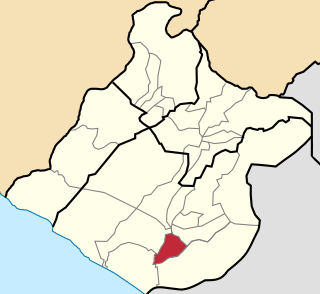

Tacna Cathedral is a church located next to the Paseo Cívico de Tacna at San Martín Avenue, in the center of the city of Tacna, Peru.


Tacna Cathedral is a church located next to the Paseo Cívico de Tacna at San Martín Avenue, in the center of the city of Tacna, Peru.
Its construction began in 1875 by the French firm of Alejandro Gustave Eiffel. Because of the War of the Pacific (1879) and the Chilean occupation, the work stopped. The church was formally completed in 1954.
It is built in the neo-renaissance architectural style. It is created with stones quarried from the hills of Intiorko and Arunta.

Tacna, officially known as San Pedro de Tacna, is a city in southern Peru and the regional capital of the Tacna Region. A very commercially active city, it is located only 35 km (22 mi) north of the border with Arica y Parinacota Region from Chile, inland from the Pacific Ocean and in the valley of the Caplina River. It is Peru's tenth most populous city.

Jorge Basadre Province is one of four provinces in the Tacna Region in southern Peru. Its capital is Locumba. The province was created on April 21, 1988 and is named after Jorge Basadre Grohmann, the country's most notable historian.

Tacna is the largest of four provinces in the Department of Tacna in southern Peru located on the border with Chile and Bolivia. Its capital is Tacna.
Locumba is a town in the Tacna Region in southern Peru. It is the capital of Jorge Basadre Province.
Tarata is a city in the Tacna Region in southern Peru. It is the capital of Tarata District and Tarata Province.
The Jorge Basadre Grohmann National University is a public university located in the city of Tacna, Peru. It was founded by Decree Law No. 1894 on August 26, 1971; academic activities started on May 13, 1972. The university is named after Jorge Basadre, a renowned Peruvian historian born in Tacna. Currently, the university is known by the acronym UNJBG and prepares students for 30 careers.

Coronel Gregorio Albarracín Lanchipa District is one of ten districts of the province Tacna in Peru.

The National Railway Museum of Peru is located in Tacna, Peru.
The San Francisco de Miculla petroglyphs, commonly known as the Miculla petroglyphs, are petroglyphs located 22 kilometres (14 mi) from Tacna, Peru. They are carved in low relief in the rocks, and depict people fighting, dancing and hunting animals. They are believed by many to be around 1500 years old, although various people date them from as wide a time period as 500 AD to 1445 AD.
Challuma is a 5,187-metre-high (17,018 ft) mountain in the Andes of southern Peru near a lake of the same name. It is situated in the Moquegua Region, Mariscal Nieto Province, Carumas District, and in the Tacna Region, Candarave Province, Candarave District. It lies northeast of the mountain Churilaca.

Tacna Ornamental Fountain, is a fountain located in Paseo Civico, the center of the city of Tacna, Peru.
Zela House, also called Zela House City Theater, is a museum located at San Martín Avenue, in the historic centre of Tacna, Peru. Francisco Antonio de Zela, an important forerunner to Peruvian independence, once lived there. Today, it is the Salon Museo Arqueologico where ceramic and textile pieces, works of wood and metal, and pre-Hispanic fishing and basket weaving tools are displayed.

Municipal Theatre of Tacna is a teatre located in the center of Tacna, Peru.
Tacna Locomotive park, is a park, located at the Alameda Bolognesi, in the center of the city of Tacna, Peru.
Tacna Historical Museum is a museum located in the center of the city of Tacna, Peru.
The Tacna Parabolic Arch is a monument located in the Paseo Civico, in the center of the city of Tacna, Peru. It was raised in honor of the heroes of the War of the Pacific, like Admiral Miguel Grau and Colonel Francisco Bolognesi. Its construction is made of quarried pink stone. Ex-president Manuel Prado inaugurated it.

The district of La Yarada Los Palos is one of the 11 districts that constitute the province of Tacna in the Tacna Region, in the south of Peru.

The Chilean–Peruvian territorial dispute is a territorial dispute between Chile and Peru that started in the aftermath of the War of the Pacific and ended significantly in 1929 with the signing of the Treaty of Lima and in 2014 with a ruling by the International Court of Justice. The dispute applies since 2014 to a 37,610 km2 territory in the Chile–Peru border, as a result of the maritime dispute between both states.

The Tacna–Arica railway is a transnational railway that connects the cities of Tacna and Arica, located in Peru and Chile, respectively. Agreed upon as part of the 1929 Treaty of Lima, it has a length of 62 km (39 mi) and a track gauge of 1,435 mm (4.708 ft). It is currently administered by the Regional Government of Tacna and operates since May 28, 2016, after being suspended since March 12, 2012.

The Port of Arica is the main port of the northernmost coastal Chilean city of Arica. The northern part of the port, known by its acronym, MASP Arica, is operated by the Peruvian State.